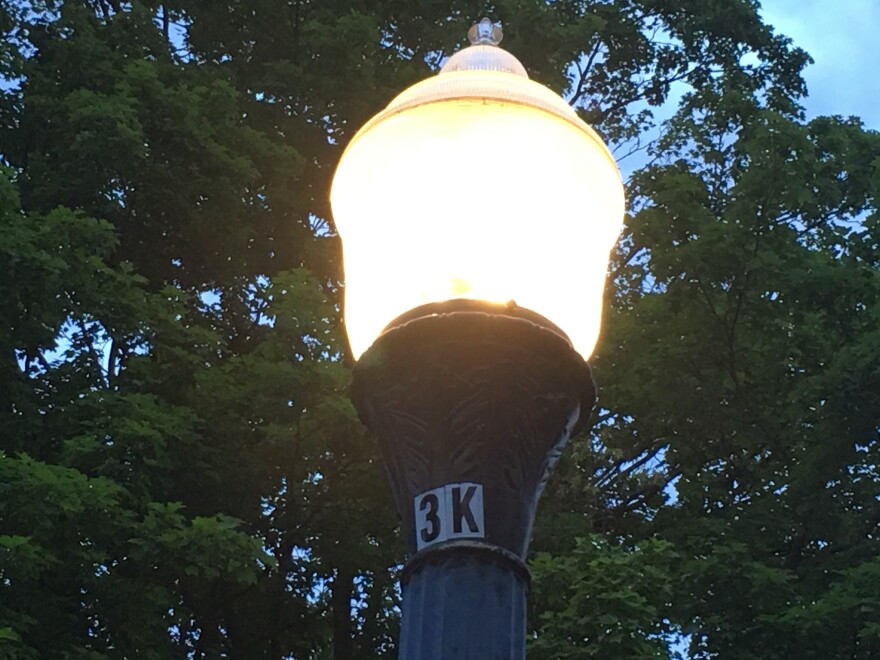Cities around the country are changing colors, from a warm yellow shade to more of an institutional blue. The change comes from above: They're replacing old streetlight bulbs with new, energy-efficient LED bulbs.
Columbus city officials say the transition will cut public lighting costs in half, but LED lights have raised concerns from some residents and medical experts.
The biggest reason for the change, says James Gross of the Columbus Division of Power, is money. LEDs require a lot less electricity to light up neighborhoods.
"In 2016, just ballpark figures, to operate the streetlight system in Columbus we used about 39 million kilowatt hours. The hope would be to reduce that by about half going to LED," Gross says. "We’re looking at roughly $1 million to $1.2 million savings a year to operate the streetlight system."
Gross says the city conducted trials of certain LED bulbs last year and invited public comment. The trial is over, but some of the original LEDs still illuminate a street in Clintonville from dusk to dawn.
As Clintonville area commissioner Matthew Cull walks up Northridge Road toward Indianola, it’s easy to see where the old fashioned, energy-hungry bulbs end and where the LEDs begin.
"So the older lights, it’s more of a diffuse and yellow-tinted glow," Cull says. "As we’re looking due east from the corner of Granden and Northridge, is where you have the first lights in the test. The lights are clearly brighter."

In its trial, the city tested two types of LEDs: A dimmer bulb rated at 3,000 Kelvin and a brighter, 4,000 Kelvin bulb.
From the street, Cull can easily tell which is which: The 4,000 Kelvin bulb, he says, "is hard to look at."
The public response was overwhelming. Cull says people, like him, preferred the more mellow bulb over the brighter one.
"I mean it’s too bright if you’re going to stand underneath and stare at it, sure," Cull says. "As far as it being too bright for the residents that have to live right next to it, the vast majority of people liked the 3,000 Kelvin bulbs."
Also hoping to see dimmer LED streetlights is the American Medical Association. Last year the AMA issued guidelinesmeant to reduce the risk of high intensity LED lighting on human health. The AMA says LEDs at 4,000 Kelvin and above have substantial adverse impacts on sleep quality and duration.
LEDs, the AMA says, lead to impaired daytime functioning, excessive sleepiness and even obesity.
Gross says resident comments and the AMA’s guidelines led them to go with the less-brilliant 3,000 Kelvin bulbs.
"The driving factor was input from the community," Gross says. "I mean, we wanted to do what was right for Columbus. The AMA report certainly came into play."
Other cities have installed 4,000 Kelvin LEDs, with less than stellar results. Los Angeles, Phoenix and Honolulu have had to do some backtracking, mostly because of resident complaints.
Some residents support Columbus’ move to the lower-strength LEDs. One Northridge Road resident told me “he’s all for it.” So is the local chapter of the Sierra Club.
"At the Sierra Club, we know that LEDs save our taxpayers and city money, by cutting energy waste, by increasing efficiencies and by requiring less maintenance since LEDs last much longer than conventional bulbs," says David Roseman, chair of the Central Ohio Sierra Club.
It might lead to long-term savings, but the switch takes a big up-front investment. So the Gross says the city is doing it in stages - while looking for other ways to pay for the conversion.
"The citywide conversion of the 53,000 streetlights that we do have would run between $40 million and $50 million," Gross says. "For the Division of Power, that would be a massive project. Our annual capital budgets are usually on the order of $3 million to $4 million a year. So to put that into perspective, it could be a lengthy process."




